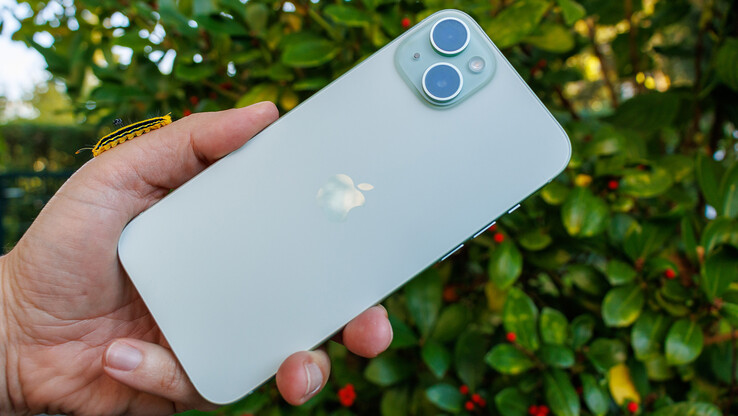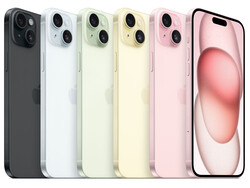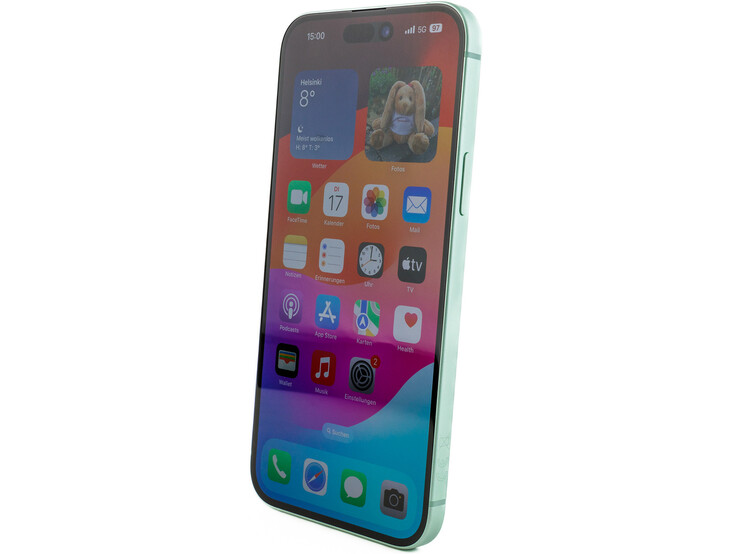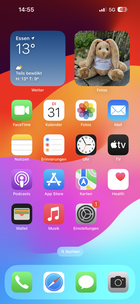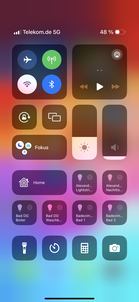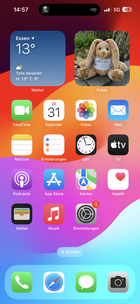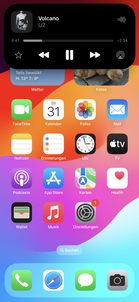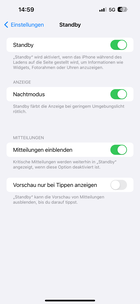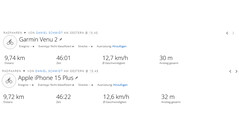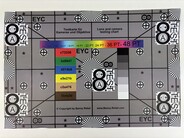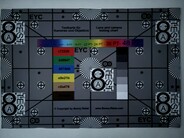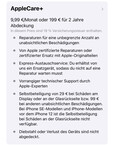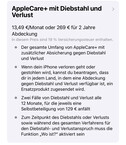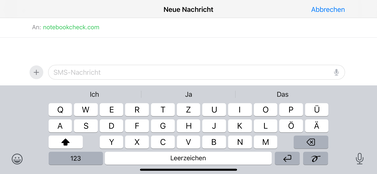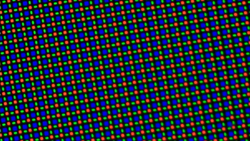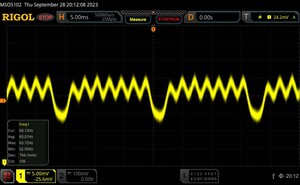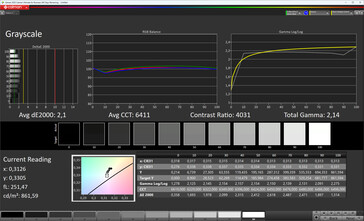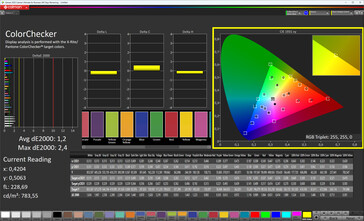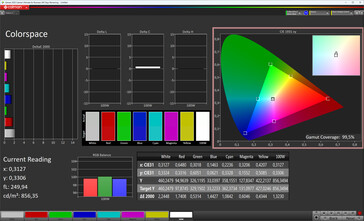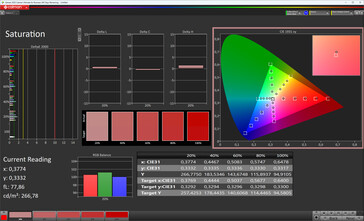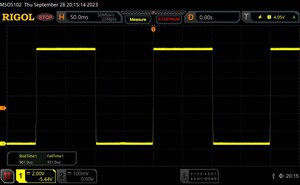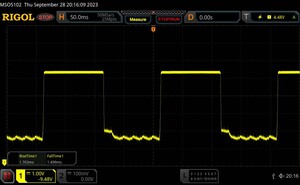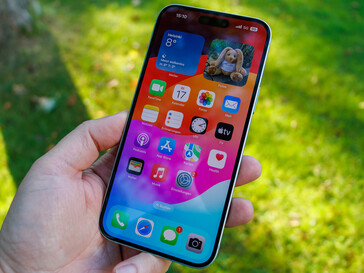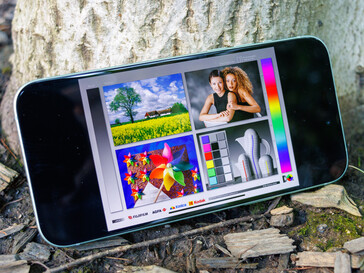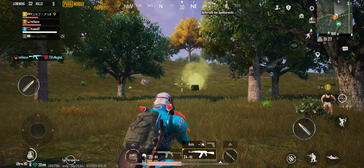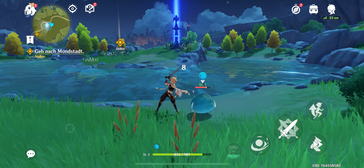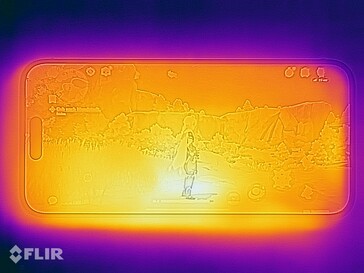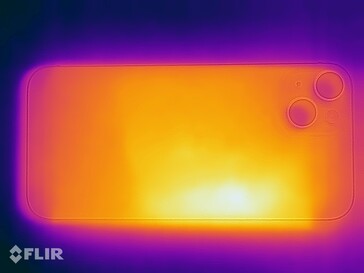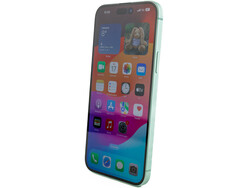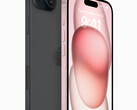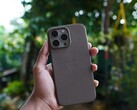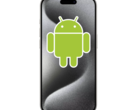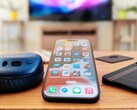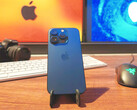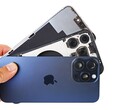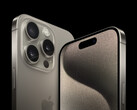Apple iPhone 15 Plus review – The iPhone with an extra-large display and powerful battery
The Apple iPhone 15 Plus is the direct successor of the iPhone 14 Plus and the larger sibling of the iPhone 15. Only its display size, dimensions, and battery power differ from the latter.
But some pleasant news first: the iPhone Plus is becoming more affordable. The entry level price drops by 50 Euros (~$53), resulting in an MSRP of 1,099 Euros (~$1161) for the smallest storage equipment version, which is also our test unit. It is possible that this can be traced back to the exchange rates, which are currently more beneficial for Europe. The following table shows all the prices:
| Storage | iPhone 15 Plus | iPhone 14 Plus | Difference |
|---|---|---|---|
| 128 GB | 1,099 EUR (~$1,161) | 1,149 EUR (~$1,214) | -50 EUR (~$53) (-4,35 %) |
| 256 GB | 1,229 EUR (~$1,299) | 1,279 EUR (~$1,352) | -50 EUR (~$53) (-3,91 %) |
| 512 GB | 1,479 EUR (~$1,563) | 1,539 EUR (~$1,626) | -60 EUR (~$63) (-3,90 %) |
The basic design of the iPhone 15 Plus remains the same, only in front you now can see the Dynamic Island, which replaces the notch. Another obvious change is the replacement of the Lightning port with USB-C. In addition, the Apple smartphone received a more powerful SoC and now also a 48-MP camera that we already know from the iPhone 14 Pro. Our test shows all the details.
Possible Competitors in Comparison
Rating | Date | Model | Weight | Drive | Size | Resolution | Price |
|---|---|---|---|---|---|---|---|
| 89.7 % v7 (old) | 11 / 2023 | Apple iPhone 15 Plus A16, A16 GPU 5-Core | 201 g | 128 GB NVMe | 6.70" | 2796x1290 | |
| 89 % v7 (old) | 12 / 2023 | Google Pixel 8 Pro Tensor G3, Mali-G715 MP7 | 213 g | 128 GB UFS 3.1 Flash | 6.70" | 2992x1344 | |
| 90.3 % v7 (old) | 03 / 2023 | Samsung Galaxy S23+ SD 8 Gen 2 for Galaxy, Adreno 740 | 195 g | 256 GB UFS 4.0 Flash | 6.60" | 2340x1080 | |
| 86 % v7 (old) | 08 / 2023 | Honor 90 5G SD 7 Gen 1, Adreno 644 | 183 g | 512 GB UFS 3.1 Flash | 6.70" | 2664x1200 | |
| 88.1 % v7 (old) | 10 / 2023 | Xiaomi 13T Pro Dimensity 9200+, Immortalis-G715 MP11 | 206 g | 512 GB UFS 4.0 Flash | 6.67" | 2712x1220 |
Case - Matte aluminum and glass
The exterior of the Apple iPhone 15 Plus remains almost unchanged from the predecessor. The height is the same, but the smartphone is now 0.3 mm (~0.012 in) slimmer and its length has increased by 0.1 mm (~0.004 in). The camera in the back sticks out by up to 3.5 mm (~0.14 in).
The iPhone 15 Plus has a matte aluminum frame and the glass in the back is also matte, preventing fingerprints from showing. The edges are now slightly rounded, making the Apple smartphone more comfortable to hold in the hand than its predecessor. Even if it is 2 grams (~0.07 oz) lighter than the iPhone 14 Plus, at 201 grams (~7 oz) it surely is not a lightweight.
The workmanship is really good. Only the gaps between the glass in the back and the frame aren't completely even in our test unit, and the iPhone 15 Plus produces some slight creaking noises from the insides when trying to warp it.
The smartphone is water and dustproof according to the IP68 standard. It is available in blue, rosé, yellow, green, and black color.
Equipment - iPhone 15 Plus comes with Dynamic Island
The equipment of the iPhone 15 Plus shows several differences compared to its predecessor. For one, it forgoes the Lightning port for the first time, replacing it with USB-C. Then the notch has also disappeared and is replaced by the Dynamic Island, where the front camera and Face ID are embedded in the display. In contrast to the iPhone 15 Pro Max, the 15 Plus doesn't offer an action key but continues to use the already known silencing key.
In terms of data transfer, the USB port only uses the 2.0 standard, which offers the same speed as the Lightning port before. In a copy test using an externally connected M2.SSD (Samsung 980 Pro in Asus ROG Strix Arion, USB 3.2 Gen. 2), at least the data is transferred at 40.43 MB/s. For connected storage media, the FAT32, exFAT, NTFS (read only), Mac OS Extended, and APFS file systems are supported. Considering the price class, a faster USB standard would have been more appropriate. In terms of wired display output, Apple doesn't make as many compromises, since it is possible to use Ultra HD with HDR at best.
In addition, MagSafe, Bluetooth 5.3, NFC, and an ultrawide band chip (UWB) of the 2nd generation are also integrated.
Software - iOS 17 for the Apple smartphone
While the Apple iPhone 15 Plus was originally delivered with iOS 17, it already received several updates during our testing period, ending up with version 17.1. Apple doesn't offer any specifics on the update period, but we can assume that it will get updates for at least five years.
With the Dynamic Island, there is an additional notification and operation element that we already know from the iPhone 14 Pro and 14 Pro Max.
We already gave some detailed information on the changes with iOS 17 in our test of the iPhone 15 Pro Max, and Apple also provides some information on this on a specific web page.
Communication and GNSS - Exact locating but no 6-GHz WLAN
To connect with the mobile Internet, the iPhone 15 Plus is able to offer a very wide frequency support. In everyday operation, the smartphone shows good reception qualities in city surroundings.
For WLAN, Wi-Fi 6 is available at best, which isn't really appropriate considering the price class. At least support of Wi-Fi 6E and its connected 6-GHz frequency band would have been more suitable. On the other hand, the transfer rates are fairly decent and very constant.
| Networking | |
| Apple iPhone 15 Plus | |
| iperf3 receive AXE11000 | |
| iperf3 transmit AXE11000 | |
| Google Pixel 8 Pro | |
| iperf3 receive AXE11000 | |
| iperf3 transmit AXE11000 | |
| iperf3 transmit AXE11000 6GHz | |
| iperf3 receive AXE11000 6GHz | |
| Samsung Galaxy S23+ | |
| iperf3 receive AXE11000 | |
| iperf3 transmit AXE11000 | |
| iperf3 transmit AXE11000 6GHz | |
| iperf3 receive AXE11000 6GHz | |
| Honor 90 5G | |
| iperf3 receive AXE11000 | |
| iperf3 transmit AXE11000 | |
| Xiaomi 13T Pro | |
| iperf3 receive AXE11000 | |
| iperf3 transmit AXE11000 | |
| iperf3 transmit AXE11000 6GHz | |
| iperf3 receive AXE11000 6GHz | |
| Apple iPhone 14 Plus | |
| iperf3 receive AXE11000 | |
| iperf3 transmit AXE11000 | |
| Average of class Smartphone | |
| iperf3 receive AXE11000 | |
| iperf3 transmit AXE11000 | |
| iperf3 transmit AXE11000 6GHz | |
| iperf3 receive AXE11000 6GHz | |
To determine its location, the iPhone 15 Plus is able to use all the global satellite networks, but only with single-band support. Despite this limitation, the Apple smartphone is able to locate itself very accurately in our test.
On a short bike tour, we compare it against the Garmin Venu 2. With an overall route length of almost 10 kilometers (~6.2 miles), the difference between the route recordings of both devices is only 20 meters (~66 ft). The iPhone also doesn't show any larger deviations in the detailed route recording.
Telephone Functions and Voice Quality
In terms of its SIM support, the iPhone 15 Plus doesn't lack anything that is offered by the Pro models. In Germany, you continue to have the option to use a physical Nano-SIM card, which you can then also combine with an additional eSIM. Alternatively, you can also use it in pure dual-eSIM operation. Functions such as VoLTE and WLAN calls are also supported.
Using the earpiece, the iPhone 15 Plus produces a natural voice quality on both sides of the conversation. Surrounding noises are filtered out fairly reliably, with only a few loud noises such as traffic noise getting through from time to time. The speaker also produces an attractive voice quality, even though there can be some slight echo at times.
Cameras - iPhone 15 Plus with 48 MP and 2x zoom
The iPhone 15 Plus again uses an identical front camera with 12 MP. It offers autofocus and delivers good results as long as there is sufficient light. It is able to record videos in Ultra HD resolution at up to 60 FPS.
For the first time, the main camera now uses a 48-MP sensor that is able to provide optical image stabilization (OIS) with sensor shifting. Via pixel binning, you can optionally create 12 MP or 24 MP recordings. The iPhone 15 Plus doesn't include an optical zoom, instead using a similar method as the Sony Xperia 5 V, which makes use of the high resolution of the main camera for an almost lossless digital zoom (always 12 MP). The results are attractive, but those who want to get even closer will quickly lose some of the quality.
In addition, there is also an ultrawide angle sensor, although its basic noise level is fairly high, delivering useful results only for social media at best.
The Apple smartphone continues to be able to record videos in Ultra HD resolution at up to 60 FPS and with Dolby Vision. Cinema mode with adjustable Bokeh level is also available in 4k at up to 30 FPS. You only have to live without Apple ProRes and ProRAW.
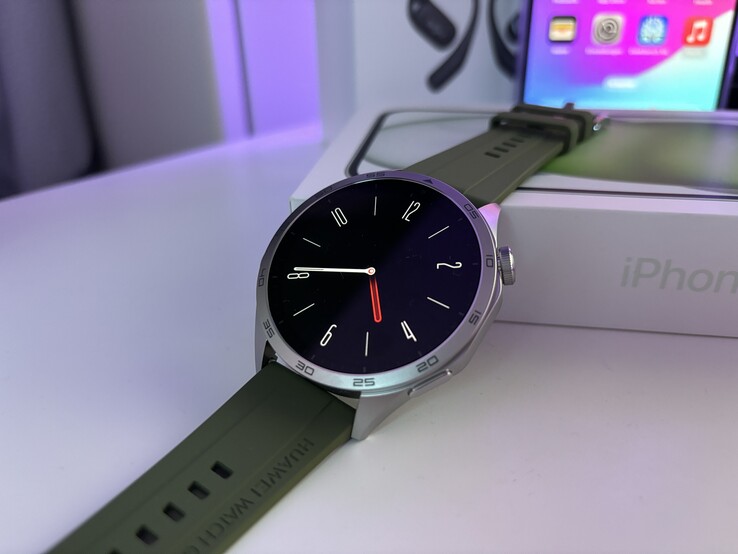
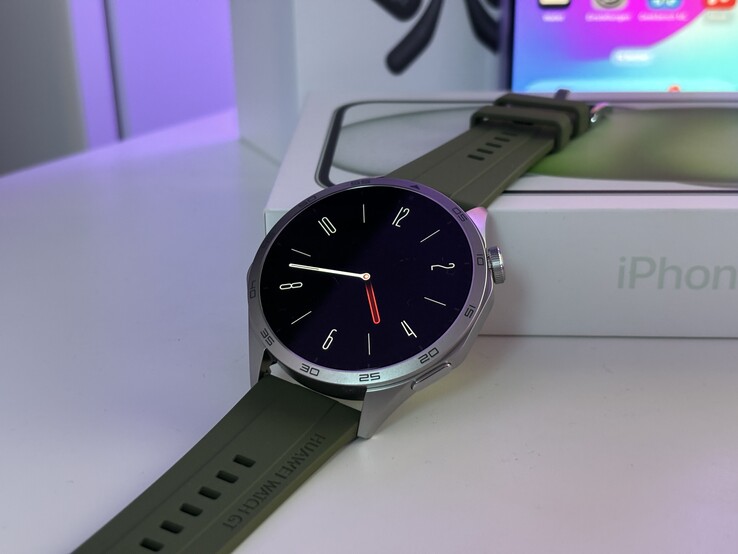
Image comparison
Choose a scene and navigate within the first image. One click changes the position on touchscreens. One click on the zoomed-in image opens the original in a new window. The first image shows the scaled photograph of the test device.
HauptkameraHauptkameraUltraweitwinkel5-facher ZoomLow-LightWe run some additional tests with the camera of the iPhone 15 Plus under controlled light conditions in our lab. The recording of the ColorChecker chart succeeds in looking quite natural. Only the green color tones have elevated DeltaE values, with all of them being reproduced too bright and saturated. The test chart is recorded with a high detail level, only showing some minimal blurriness in the edge areas.
Pictures taken in very little light (1 Lux) are brightened heavily by the automatic night mode. In our test, the automatic chose a 2-second exposure time, which isn't easy to manage anymore holding the phone in the hand.
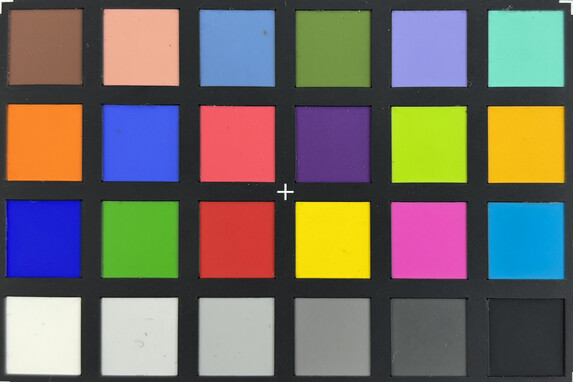
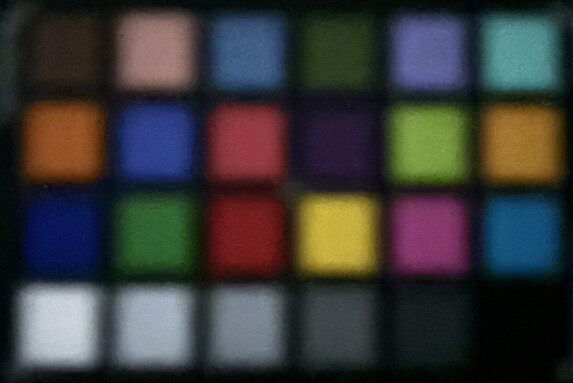
Accessories and Warranty - Meager box contents
The contents of the iPhone 15 Plus box turn out very meager, with only a USB cable (USB 2.0), a SIM tool, and an Apple sticker included in the box. However, Apple offers numerous additional optional accessories such as cases and chargers at its online shop.
The warranty is only for 12 months, although this doesn't affect the legally required warranty requirements (of 2 years in Germany). Apple continues to offer the 2-year Care+ insurance package for a one-time cost of 199 Euros (~$214). This includes unlimited repairs for accidental damage, an express replacement service, and priority support. Depending on the damage, there might also be some additional costs. For 269 Euros (~$289), you can also get an insurance against theft or loss, with a limit of two cases a year. If you prefer, you can also pay monthly for the services (9.99 or 13.49 Euros, ~$10.72 or $14.48), which includes a two-year duration but can also go for longer.
Input Devices and Operation - iPhone 15 Plus comes without an Action key
The capacitive touchscreen of the iPhone 15 Plus offers very good sliding characteristics and implements inputs very accurately. However, our test unit still shows some slight stutter from time to time, which surely cannot only be traced back to the 60-Hz panel. The iPad Air 4, for example, uses the same refresh rate with a weaker SoC, and its operation is still extremely smooth.
Face ID provides biometric security, with its sensors being located in the Dynamic Island. The face recognition is considered very secure and works reliably and quickly. The Action key that we know from the Pro models can nowhere be found in the iPhone 15 Plus, but there continues to be a purely mechanic silencing key.
The Taptic Engine handles vibrations. This is an electromagnetic linear motor that ensures crisp and haptically pleasing feedback. Other functions such as AssistiveTouch, single-hand mode, or tapping gestures for the back continue to be included.
Display - Brighter but only 60 Hz again
The 6.7-inch (17.02 cm) display of the Apple iPhone 15 Plus offers a very high pixel density of 460 PPI, and its contents look correspondingly sharp and crisp. However, the refresh rate is only a fixed 60 Hz, which is not up to the current standards of a smartphone beyond the 1,000-Euro price limit anymore. The smartphone supports the HLG, HDR10, and Dolby Vision HDR standards.
The brightness has increased compared to the iPhone 14 Plus predecessor, now reaching up to 1,045 cd/m² with activated brightness sensor and pure white display content. In one measurement with activated HDR, we are even able to get up to 2,397 cd/m² from the panel. Apple actually only speaks about 1,600 nits for HDR and up to 2,000 nits outdoors. Those who adjust the brightness manually will get a maximum of up to 872 cd/m².
In our measurement at minimum display brightness with the oscilloscope, the iPhone 15 Plus reveals a constant flickering at 60 Hz, whose amplitude remains stable. The flicker meter even shows up to 480 Hz for the smartphone, but sensitive users may still encounter some difficulties using the panel.
| |||||||||||||||||||||||||
Brightness Distribution: 99 %
Center on Battery: 1044 cd/m²
Contrast: ∞:1 (Black: 0 cd/m²)
ΔE ColorChecker Calman: 1.2 | ∀{0.5-29.43 Ø4.77}
ΔE Greyscale Calman: 2.1 | ∀{0.09-98 Ø5}
99.5% sRGB (Calman 2D)
Gamma: 2.14
CCT: 6411 K
| Apple iPhone 15 Plus OLED, 2796x1290, 6.7" | Google Pixel 8 Pro OLED, 2992x1344, 6.7" | Samsung Galaxy S23+ Dynamic AMOLED 2x, 2340x1080, 6.6" | Honor 90 5G AMOLED, 2664x1200, 6.7" | Xiaomi 13T Pro AMOLED, 2712x1220, 6.7" | Apple iPhone 14 Plus OLED, 2778x1284, 6.7" | |
|---|---|---|---|---|---|---|
| Screen | 8% | -37% | -23% | -4% | -2% | |
| Brightness middle (cd/m²) | 1044 | 1510 45% | 1128 8% | 1180 13% | 1252 20% | 797 -24% |
| Brightness (cd/m²) | 1040 | 1467 41% | 1136 9% | 1202 16% | 1230 18% | 800 -23% |
| Brightness Distribution (%) | 99 | 92 -7% | 99 0% | 88 -11% | 96 -3% | 97 -2% |
| Black Level * (cd/m²) | ||||||
| Colorchecker dE 2000 * | 1.2 | 1.1 8% | 2.7 -125% | 1.5 -25% | 1.4 -17% | 0.97 19% |
| Colorchecker dE 2000 max. * | 2.4 | 3.8 -58% | 4.5 -88% | 4.8 -100% | 3.1 -29% | 1.76 27% |
| Greyscale dE 2000 * | 2.1 | 1.7 19% | 2.6 -24% | 2.8 -33% | 2.3 -10% | 2.3 -10% |
| Gamma | 2.14 103% | 2.23 99% | 2.05 107% | 2.25 98% | 2.23 99% | 2.531 87% |
| CCT | 6411 101% | 6670 97% | 6644 98% | 6489 100% | 6590 99% | 6492 100% |
* ... smaller is better
Screen Flickering / PWM (Pulse-Width Modulation)
| Screen flickering / PWM detected | 60 Hz | ||
The display backlight flickers at 60 Hz (worst case, e.g., utilizing PWM) . The frequency of 60 Hz is very low, so the flickering may cause eyestrain and headaches after extended use. In comparison: 53 % of all tested devices do not use PWM to dim the display. If PWM was detected, an average of 8086 (minimum: 5 - maximum: 343500) Hz was measured. | |||
Measurement series with fixed zoom level and different brightness adjustments
The iPhone 15 Plus masters the color reproduction of the display really well and no color deviations can be seen with the bare eyes, at least when the True Tone function remains deactivated. However, using this feature is more gentle on the eyes, since only then, the white balance is automatically adjusted to the surrounding light, although this also results in warmer color tones.
Display Response Times
| ↔ Response Time Black to White | ||
|---|---|---|
| 1.83 ms ... rise ↗ and fall ↘ combined | ↗ 0.901 ms rise | |
| ↘ 0.931 ms fall | ||
| The screen shows very fast response rates in our tests and should be very well suited for fast-paced gaming. In comparison, all tested devices range from 0.1 (minimum) to 240 (maximum) ms. » 9 % of all devices are better. This means that the measured response time is better than the average of all tested devices (20.2 ms). | ||
| ↔ Response Time 50% Grey to 80% Grey | ||
| 3.26 ms ... rise ↗ and fall ↘ combined | ↗ 1.763 ms rise | |
| ↘ 1.499 ms fall | ||
| The screen shows very fast response rates in our tests and should be very well suited for fast-paced gaming. In comparison, all tested devices range from 0.165 (minimum) to 636 (maximum) ms. » 13 % of all devices are better. This means that the measured response time is better than the average of all tested devices (31.6 ms). | ||
Performance - iPhone with Apple A16 Bionic
The iPhone 15 Plus is run by the Apple A16 Bionic processor, which was used in the iPhone 14 Pro and 14 Pro Max for the first time. The SoC is able to use 6 GB of working memory and promises a high performance.
This is also confirmed by the benchmark results. In terms of the CPU performance, the iPhone doesn't have to shy away from any comparison, despite only offering last year's SoC. The AI performance also turns out high. However, we continue to notice some small stutters in everyday operation, and Apple still has some room for optimization here.
| Geekbench ML | |
| 0.5 TensorFlow Lite CPU 0.5 | |
| Apple iPhone 15 Plus | |
| Average Apple A16 Bionic (1016 - 1135, n=3) | |
| Samsung Galaxy S23 | |
| Google Pixel 8 Pro | |
| 0.5 TensorFlow Lite GPU | |
| Samsung Galaxy S23 | |
| Average Apple A16 Bionic (2207 - 2540, n=3) | |
| Apple iPhone 15 Plus | |
| Google Pixel 8 Pro | |
| 0.5 TensorFlow Lite NNAPI / Core ML | |
| Apple iPhone 15 Plus | |
| Average Apple A16 Bionic (3170 - 3377, n=4) | |
| Google Pixel 8 Pro | |
| Samsung Galaxy S23 | |
Although the Apple A16 Bionic GPU doesn't support hardware-based raytracing yet, it still delivers a good performance in this regard, even if some competitors such as the Galaxy S23 (Adreno 740) or Xiaomi 13T Pro (Immortalis-G715 MP11) offer an even higher performance.
That is not only the case for the raytracing performance (3DMark), but also in general, since the iPhone also does worse in the offscreen benchmarks of GFXBench.
GFXBench (DX / GLBenchmark) 2.7: T-Rex Onscreen | 1920x1080 T-Rex Offscreen
GFXBench 3.0: on screen Manhattan Onscreen OGL | 1920x1080 1080p Manhattan Offscreen
GFXBench 3.1: on screen Manhattan ES 3.1 Onscreen | 1920x1080 Manhattan ES 3.1 Offscreen
GFXBench: on screen Car Chase Onscreen | 1920x1080 Car Chase Offscreen | on screen Aztec Ruins High Tier Onscreen | 2560x1440 Aztec Ruins High Tier Offscreen | on screen Aztec Ruins Normal Tier Onscreen | 1920x1080 Aztec Ruins Normal Tier Offscreen | 3840x2160 4K Aztec Ruins High Tier Offscreen
| 3DMark / Wild Life Extreme Unlimited | |
| Samsung Galaxy S23 | |
| Xiaomi 13T Pro | |
| Apple iPhone 14 Plus | |
| Apple iPhone 15 Plus | |
| Google Pixel 8 Pro | |
| Honor 90 5G | |
| 3DMark / Wild Life Extreme | |
| Samsung Galaxy S23 | |
| Apple iPhone 15 Plus | |
| Xiaomi 13T Pro | |
| Apple iPhone 14 Plus | |
| Google Pixel 8 Pro | |
| Honor 90 5G | |
| 3DMark / Wild Life Unlimited Score | |
| Samsung Galaxy S23 | |
| Apple iPhone 15 Plus | |
| Xiaomi 13T Pro | |
| Apple iPhone 14 Plus | |
| Google Pixel 8 Pro | |
| Honor 90 5G | |
| 3DMark / Solar Bay Score | |
| Samsung Galaxy S23 | |
| Xiaomi 13T Pro | |
| Apple iPhone 15 Plus | |
| 3DMark / Solar Bay Unlimited Score | |
| Samsung Galaxy S23 | |
| Xiaomi 13T Pro | |
| Apple iPhone 15 Plus | |
| GFXBench (DX / GLBenchmark) 2.7 / T-Rex Onscreen | |
| Samsung Galaxy S23 | |
| Xiaomi 13T Pro | |
| Google Pixel 8 Pro | |
| Honor 90 5G | |
| Apple iPhone 15 Plus | |
| Apple iPhone 14 Plus | |
| GFXBench (DX / GLBenchmark) 2.7 / T-Rex Offscreen | |
| Xiaomi 13T Pro | |
| Apple iPhone 15 Plus | |
| Samsung Galaxy S23 | |
| Apple iPhone 14 Plus | |
| Google Pixel 8 Pro | |
| Honor 90 5G | |
| GFXBench 3.0 / Manhattan Onscreen OGL | |
| Samsung Galaxy S23 | |
| Xiaomi 13T Pro | |
| Google Pixel 8 Pro | |
| Honor 90 5G | |
| Apple iPhone 15 Plus | |
| Apple iPhone 14 Plus | |
| GFXBench 3.0 / 1080p Manhattan Offscreen | |
| Xiaomi 13T Pro | |
| Samsung Galaxy S23 | |
| Apple iPhone 15 Plus | |
| Apple iPhone 14 Plus | |
| Google Pixel 8 Pro | |
| Honor 90 5G | |
| GFXBench 3.1 / Manhattan ES 3.1 Onscreen | |
| Samsung Galaxy S23 | |
| Xiaomi 13T Pro | |
| Google Pixel 8 Pro | |
| Apple iPhone 15 Plus | |
| Apple iPhone 14 Plus | |
| Honor 90 5G | |
| GFXBench 3.1 / Manhattan ES 3.1 Offscreen | |
| Xiaomi 13T Pro | |
| Apple iPhone 15 Plus | |
| Samsung Galaxy S23 | |
| Apple iPhone 14 Plus | |
| Google Pixel 8 Pro | |
| Honor 90 5G | |
| GFXBench / Car Chase Onscreen | |
| Samsung Galaxy S23 | |
| Xiaomi 13T Pro | |
| Google Pixel 8 Pro | |
| Apple iPhone 15 Plus | |
| Apple iPhone 14 Plus | |
| Honor 90 5G | |
| GFXBench / Car Chase Offscreen | |
| Samsung Galaxy S23 | |
| Apple iPhone 15 Plus | |
| Apple iPhone 14 Plus | |
| Xiaomi 13T Pro | |
| Google Pixel 8 Pro | |
| Honor 90 5G | |
| GFXBench / Aztec Ruins High Tier Onscreen | |
| Samsung Galaxy S23 | |
| Xiaomi 13T Pro | |
| Google Pixel 8 Pro | |
| Apple iPhone 15 Plus | |
| Apple iPhone 14 Plus | |
| Honor 90 5G | |
| GFXBench / Aztec Ruins High Tier Offscreen | |
| Samsung Galaxy S23 | |
| Xiaomi 13T Pro | |
| Apple iPhone 15 Plus | |
| Apple iPhone 14 Plus | |
| Google Pixel 8 Pro | |
| Honor 90 5G | |
| GFXBench / Aztec Ruins Normal Tier Onscreen | |
| Samsung Galaxy S23 | |
| Google Pixel 8 Pro | |
| Xiaomi 13T Pro | |
| Apple iPhone 15 Plus | |
| Apple iPhone 14 Plus | |
| Honor 90 5G | |
| GFXBench / Aztec Ruins Normal Tier Offscreen | |
| Samsung Galaxy S23 | |
| Apple iPhone 15 Plus | |
| Xiaomi 13T Pro | |
| Apple iPhone 14 Plus | |
| Google Pixel 8 Pro | |
| Honor 90 5G | |
| GFXBench / 4K Aztec Ruins High Tier Offscreen | |
| Samsung Galaxy S23 | |
| Xiaomi 13T Pro | |
| Apple iPhone 15 Plus | |
| Apple iPhone 14 Plus | |
| Google Pixel 8 Pro | |
| Honor 90 5G | |
The iPhone 15 Plus performs flawlessly when surfing the web. This is the case with both the subjective surfing behavior as well as the benchmarks, where the Apple smartphone easily leaves the competitors behind.
| Jetstream 2 - 2.0 Total Score | |
| Average Apple A16 Bionic (228 - 282, n=5) | |
| Apple iPhone 15 Plus (Safari Mobile 17) | |
| Apple iPhone 14 Plus (Safari 16) | |
| Samsung Galaxy S23+ (Chrome 110.0.5481.65) | |
| Average of class Smartphone (23.8 - 387, n=148, last 2 years) | |
| Xiaomi 13T Pro (Chrome 117) | |
| Google Pixel 8 Pro (Chrome 117) | |
| Honor 90 5G (chrome 115) | |
| Speedometer 2.0 - Result 2.0 | |
| Apple iPhone 15 Plus (Safari Mobile 17) | |
| Average Apple A16 Bionic (327 - 419, n=4) | |
| Apple iPhone 14 Plus (Safari 16) | |
| Average of class Smartphone (15.2 - 643, n=120, last 2 years) | |
| Xiaomi 13T Pro (Chrome 117) | |
| Google Pixel 8 Pro (Chrome 117) | |
| Samsung Galaxy S23+ (Chrome 110.0.5481.65) | |
| Honor 90 5G (chrome 115) | |
| WebXPRT 4 - Overall | |
| Average Apple A16 Bionic (201 - 236, n=3) | |
| Apple iPhone 14 Plus (Safari 16) | |
| Samsung Galaxy S23+ (Chrome 110.0.5481.65) | |
| Average of class Smartphone (27 - 306, n=144, last 2 years) | |
| Google Pixel 8 Pro (Chrome 117) | |
| Xiaomi 13T Pro (Chrome 117) | |
| Honor 90 5G (Chrome 115) | |
| Octane V2 - Total Score | |
| Apple iPhone 15 Plus (Safari Mobile 17) | |
| Average Apple A16 Bionic (68554 - 75718, n=5) | |
| Apple iPhone 14 Plus (Safari 16) | |
| Samsung Galaxy S23+ (Chrome 110.0.5481.65) | |
| Average of class Smartphone (2228 - 126661, n=195, last 2 years) | |
| Google Pixel 8 Pro (Chrome 117) | |
| Xiaomi 13T Pro (Chrome 117) | |
| Honor 90 5G (chrome 115) | |
| Mozilla Kraken 1.1 - Total | |
| Honor 90 5G (chrome 115) | |
| Xiaomi 13T Pro (Chrome 117) | |
| Average of class Smartphone (257 - 28190, n=155, last 2 years) | |
| Google Pixel 8 Pro (Chrome 117) | |
| Samsung Galaxy S23+ (Chrome 110.0.5481.65) | |
| Apple iPhone 14 Plus (Safari 16) | |
| Average Apple A16 Bionic (411 - 506, n=5) | |
| Apple iPhone 15 Plus (Safari Mobile 17) | |
* ... smaller is better
Games - iPhone 15 Plus with a maximum of 60 FPS
The iPhone 15 Plus fulfills all the requirements for a good gaming smartphone: a powerful GPU, a large display, and good dual-speakers. Unfortunately, we are unable to show you any measurements with GameBench, since that hasn't been optimized for iOS 17 yet. However, we will add those as soon as possible.
At the same time, we already tried playing PUBG Mobile and Genshin Impact on the Apple smartphone. Both of these games run very smoothly, even at the highest detail level. In Genshin Impact, only the medium detail level is preset at a maximum of 30 FPS, but this can be changed easily.
Emissions - Two speakers for the iPhone 15 Plus
Temperatures
Even though the surface temperatures of the Apple iPhone 15 Plus warm up noticeably under load, they still remain below 40 °C (104 °F).
In the stress tests of 3DMark, the Apple smartphone shows some loss in performance on the long run, but it is still faster than a Galaxy S23+.
(+) The maximum temperature on the upper side is 38.4 °C / 101 F, compared to the average of 35.2 °C / 95 F, ranging from 21.9 to 247 °C for the class Smartphone.
(+) The bottom heats up to a maximum of 39.5 °C / 103 F, compared to the average of 34 °C / 93 F
(+) In idle usage, the average temperature for the upper side is 28.9 °C / 84 F, compared to the device average of 32.9 °C / 91 F.
3DMark Wild Life Stress Test
| 3DMark | |
| Wild Life Stress Test Stability | |
| Honor 90 5G | |
| Apple iPhone 15 Plus | |
| Google Pixel 8 Pro | |
| Xiaomi 13T Pro | |
| Apple iPhone 14 Plus | |
| Samsung Galaxy S23+ | |
| Wild Life Extreme Stress Test | |
| Honor 90 5G | |
| Xiaomi 13T Pro | |
| Google Pixel 8 Pro | |
| Apple iPhone 15 Plus | |
| Apple iPhone 14 Plus | |
| Samsung Galaxy S23+ | |
| Solar Bay Stress Test Stability | |
| Xiaomi 13T Pro | |
| Apple iPhone 15 Plus | |
Speaker
The two speakers of the Apple iPhone 15 Plus produce a relatively good sound, but high-pitched voices can sound a bit hollow when playing music and the lower frequencies are not pronounced enough.
Those who prefer headphones or other external devices for sound can use either the USB connection or Bluetooth. But Apple still doesn't offer a High-Res codec for the latter, and users are forced to be content with AAC.
Apple iPhone 15 Plus audio analysis
(+) | speakers can play relatively loud (90.6 dB)
Bass 100 - 315 Hz
(-) | nearly no bass - on average 20.7% lower than median
(±) | linearity of bass is average (7.5% delta to prev. frequency)
Mids 400 - 2000 Hz
(+) | balanced mids - only 3.8% away from median
(+) | mids are linear (4% delta to prev. frequency)
Highs 2 - 16 kHz
(±) | higher highs - on average 5.3% higher than median
(+) | highs are linear (2.8% delta to prev. frequency)
Overall 100 - 16.000 Hz
(±) | linearity of overall sound is average (15.6% difference to median)
Compared to same class
» 4% of all tested devices in this class were better, 3% similar, 93% worse
» The best had a delta of 11%, average was 35%, worst was 134%
Compared to all devices tested
» 23% of all tested devices were better, 4% similar, 73% worse
» The best had a delta of 4%, average was 24%, worst was 134%
Samsung Galaxy S23+ audio analysis
(+) | speakers can play relatively loud (91.8 dB)
Bass 100 - 315 Hz
(-) | nearly no bass - on average 21.7% lower than median
(+) | bass is linear (5.8% delta to prev. frequency)
Mids 400 - 2000 Hz
(±) | reduced mids - on average 5.8% lower than median
(+) | mids are linear (4.3% delta to prev. frequency)
Highs 2 - 16 kHz
(+) | balanced highs - only 4.4% away from median
(+) | highs are linear (2.6% delta to prev. frequency)
Overall 100 - 16.000 Hz
(±) | linearity of overall sound is average (16.2% difference to median)
Compared to same class
» 6% of all tested devices in this class were better, 5% similar, 90% worse
» The best had a delta of 11%, average was 35%, worst was 134%
Compared to all devices tested
» 25% of all tested devices were better, 5% similar, 69% worse
» The best had a delta of 4%, average was 24%, worst was 134%
Battery Life - The battery increases to 4,383 mAh
Power Consumption
The power consumption of the iPhone 15 Plus is fairly high during idle operation at maximum display brightness, but the panel is also very bright, needing a correspondingly high amount of power.
The Apple smartphone can be charged with a wired charger at up to 20 watts, with a full charge needing less than 2 hours. In our test, the 50% mark was reached after 28 minutes. Alternatively, you can also charge the smartphone via MagSafe at up to 15 watts or wirelessly (Qi) at up to 7.5 watts.
| Off / Standby | |
| Idle | |
| Load |
|
Key:
min: | |
| Apple iPhone 15 Plus 4383 mAh | Google Pixel 8 Pro 5050 mAh | Samsung Galaxy S23+ 4700 mAh | Honor 90 5G 5000 mAh | Xiaomi 13T Pro 5000 mAh | Apple iPhone 14 Plus 4323 mAh | Average Apple A16 Bionic | Average of class Smartphone | |
|---|---|---|---|---|---|---|---|---|
| Power Consumption | -13% | 24% | -34% | -49% | -5% | -31% | -21% | |
| Idle Minimum * (Watt) | 0.71 | 0.63 11% | 0.64 10% | 1.19 -68% | 0.99 -39% | 0.7 1% | 0.842 ? -19% | 0.847 ? -19% |
| Idle Average * (Watt) | 2.09 | 1.47 30% | 0.88 58% | 1.71 18% | 1.14 45% | 1.1 47% | 2.66 ? -27% | 1.446 ? 31% |
| Idle Maximum * (Watt) | 2.11 | 1.55 27% | 0.94 55% | 1.82 14% | 1.34 36% | 1.4 34% | 2.71 ? -28% | 1.63 ? 23% |
| Load Average * (Watt) | 4.32 | 8.45 -96% | 4.18 3% | 6.8 -57% | 10.06 -133% | 6.5 -50% | 5.76 ? -33% | 6.95 ? -61% |
| Load Maximum * (Watt) | 6.25 | 8.63 -38% | 6.59 -5% | 10.93 -75% | 15.94 -155% | 9.8 -57% | 9.28 ? -48% | 11.3 ? -81% |
* ... smaller is better
Power Consumption: Geekbench (150 cd/m²)
Power Consumption: GFXBench (150 cd/m²)
Battery Life
The battery of the iPhone 15 Plus is slightly larger than that of the predecessor, with the runtimes turning out correspondingly longer. Only in the Reader’s Test at minimum display brightness, the values drop considerably, even though they are still at an excellent level.
The values are easiest to compare at an adjusted display brightness (150 cd/m²). While surfing using the the WLAN, they are at the same level as those of the Xiaomi 13T Pro and are only surpassed by the Galaxy S23+. With a continuous video reproduction loop (offline), the iPhone 15 Plus places on top of the comparison field.
| Apple iPhone 15 Plus 4383 mAh | Google Pixel 8 Pro 5050 mAh | Samsung Galaxy S23+ 4700 mAh | Honor 90 5G 5000 mAh | Xiaomi 13T Pro 5000 mAh | Apple iPhone 14 Plus 4323 mAh | |
|---|---|---|---|---|---|---|
| Battery runtime | -35% | 6% | -33% | -5% | 6% | |
| Reader / Idle (h) | 41.3 | 22.4 -46% | 43.1 4% | 20.7 -50% | 30 -27% | 55.4 34% |
| H.264 (h) | 26.4 | 18.7 -29% | 25.4 -4% | 16.5 -37% | 21.6 -18% | 25.3 -4% |
| WiFi v1.3 (h) | 18.4 | 12.7 -31% | 19.9 8% | 15 -18% | 18.3 -1% | 18.1 -2% |
| Load (h) | 5.6 | 3.7 -34% | 6.4 14% | 4.1 -27% | 7.1 27% | 5.4 -4% |
Pros
Cons
Verdict - More than just USB
The iPhone 15 Plus doesn't represent a great leap but still offers some interesting improvements. Those include not only the newly required USB connector but also the Dynamic Island, the new main camera, and the brighter display.
The qualities of the predecessor also remain: The smartphone is able to determine its own location very accurately, and the battery lasts for a really long time. In addition, the case is again water and dustproof according to the IP68 standard. Wireless charging and UWB also continues to be supported.
The Apple iPhone 15 Plus is a very good smartphone, but it doesn't offer some of the features that have become standard in its price class at this point.
On the other hand, the iPhone still gives some reasons for complaint. One of them is the lack of 6-GHz WLAN. But particularly the low refresh rate isn't up to the current standards anymore, and we were very surprised to encounter some stutters in the system. It also would have been better, if Apple had provided higher transfer rates with the USB port, and the charging times also turn out fairly long.
For those who don't necessarily need to stay within the Apple universe, the Sony Xperia 5 V or Samsung Galaxy S23+ might also be some interesting alternatives. If it has to be Apple but doesn't absolutely need to include USB, the iPhone 14 Pro Max is currently probably the better choice.
Price and Availability
Apple iPhone 15 Plus
- 11/03/2023 v7 (old)
Daniel Schmidt
Transparency
The selection of devices to be reviewed is made by our editorial team. The test sample was freely purchased by the author at his/her own expense. The lender had no influence on this review, nor did the manufacturer receive a copy of this review before publication. There was no obligation to publish this review. As an independent media company, Notebookcheck is not subjected to the authority of manufacturers, retailers or publishers.
This is how Notebookcheck is testing
Every year, Notebookcheck independently reviews hundreds of laptops and smartphones using standardized procedures to ensure that all results are comparable. We have continuously developed our test methods for around 20 years and set industry standards in the process. In our test labs, high-quality measuring equipment is utilized by experienced technicians and editors. These tests involve a multi-stage validation process. Our complex rating system is based on hundreds of well-founded measurements and benchmarks, which maintains objectivity. Further information on our test methods can be found here.


